核反应堆及其工作原理
核反应堆工作原理
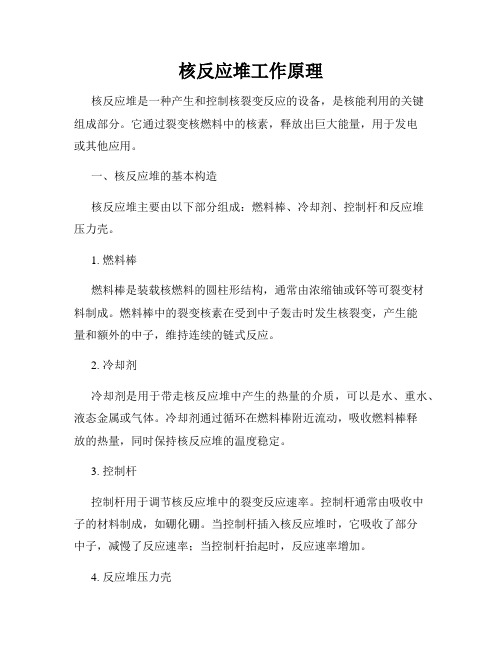
核反应堆工作原理核反应堆是一种产生和控制核裂变反应的设备,是核能利用的关键组成部分。
它通过裂变核燃料中的核素,释放出巨大能量,用于发电或其他应用。
一、核反应堆的基本构造核反应堆主要由以下部分组成:燃料棒、冷却剂、控制杆和反应堆压力壳。
1. 燃料棒燃料棒是装载核燃料的圆柱形结构,通常由浓缩铀或钚等可裂变材料制成。
燃料棒中的裂变核素在受到中子轰击时发生核裂变,产生能量和额外的中子,维持连续的链式反应。
2. 冷却剂冷却剂是用于带走核反应堆中产生的热量的介质,可以是水、重水、液态金属或气体。
冷却剂通过循环在燃料棒附近流动,吸收燃料棒释放的热量,同时保持核反应堆的温度稳定。
3. 控制杆控制杆用于调节核反应堆中的裂变反应速率。
控制杆通常由吸收中子的材料制成,如硼化硼。
当控制杆插入核反应堆时,它吸收了部分中子,减慢了反应速率;当控制杆抬起时,反应速率增加。
4. 反应堆压力壳反应堆压力壳是一个密封的容器,用于保护核反应堆内部免受外部环境的影响,并防止辐射泄漏。
它通常由厚实的钢制成,能够承受高压和高温。
二、核反应堆的工作原理核反应堆的工作原理是基于核裂变和中子链式反应。
1. 核裂变核裂变是指重核(如铀-235)被中子轰击后分裂成两个更轻的核碎片的过程,并释放出大量的能量和中子。
裂变反应是连锁反应,每一次裂变都会释放出2-3个中子,进而引发周围其他核燃料材料的裂变。
2. 中子链式反应核反应堆中的裂变释放的中子可以引发其他核燃料的裂变,形成中子链式反应。
中子链式反应是自持续的,只要提供足够的核燃料和恰当的条件,反应就可以持续进行。
在核反应堆中,裂变反应迅速释放出大量热能,增加燃料棒温度。
冷却剂通过燃料棒的表面流过,并吸收热能,随后经过热交换装置将热能传递给工质,如水或蒸汽。
工质的温度升高,通过涡轮机驱动发电机,将热能转化为电能。
同时,控制杆的调节可以控制核反应堆的反应速率。
当控制杆插入核反应堆时,它吸收了中子,减慢了反应速率。
核反应堆的工作原理
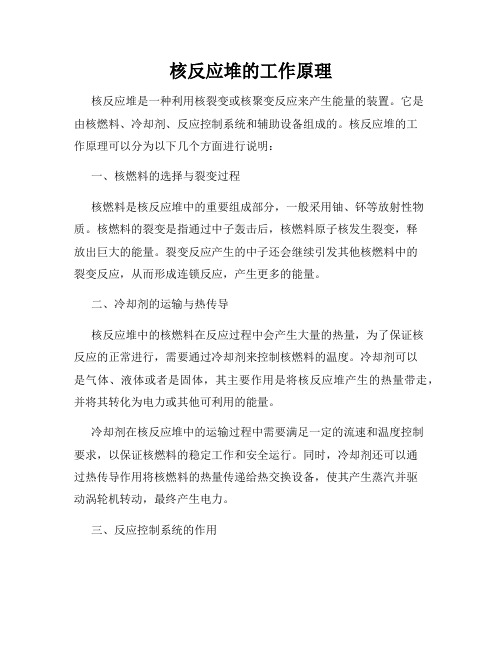
核反应堆的工作原理核反应堆是一种利用核裂变或核聚变反应来产生能量的装置。
它是由核燃料、冷却剂、反应控制系统和辅助设备组成的。
核反应堆的工作原理可以分为以下几个方面进行说明:一、核燃料的选择与裂变过程核燃料是核反应堆中的重要组成部分,一般采用铀、钚等放射性物质。
核燃料的裂变是指通过中子轰击后,核燃料原子核发生裂变,释放出巨大的能量。
裂变反应产生的中子还会继续引发其他核燃料中的裂变反应,从而形成连锁反应,产生更多的能量。
二、冷却剂的运输与热传导核反应堆中的核燃料在反应过程中会产生大量的热量,为了保证核反应的正常进行,需要通过冷却剂来控制核燃料的温度。
冷却剂可以是气体、液体或者是固体,其主要作用是将核反应堆产生的热量带走,并将其转化为电力或其他可利用的能量。
冷却剂在核反应堆中的运输过程中需要满足一定的流速和温度控制要求,以保证核燃料的稳定工作和安全运行。
同时,冷却剂还可以通过热传导作用将核燃料的热量传递给热交换设备,使其产生蒸汽并驱动涡轮机转动,最终产生电力。
三、反应控制系统的作用为了控制和调节核反应堆中的反应过程,核反应堆设有反应控制系统。
反应控制系统一般由控制棒和反应控制系统组成。
控制棒是一种可以插入或抽出核燃料组件的装置,通过调整控制棒在核燃料中的位置来改变核反应堆的反应率。
反应控制系统的主要作用是控制反应堆核燃料中的中子流,以维持核燃料的临界状态。
临界状态是指核燃料中的裂变反应和中子释放保持平衡,即核燃料中每个反应产生的中子数等于引发下次裂变反应所需要的中子数,确保核燃料的稳定工作。
四、辅助设备的作用核反应堆还需要一些辅助设备来保证其正常运行。
辅助设备主要包括核反应堆的防护层、安全控制系统、辐射监测系统等。
防护层是为了防止辐射能量泄漏,保护人员和环境安全。
安全控制系统则负责监测核反应堆的运行状况,一旦检测到异常情况,及时采取相应的措施保障安全。
辐射监测系统用于监测核反应堆产生的辐射能量,及时发现和处理辐射泄漏等突发情况。
核反应堆工作原理

核反应堆工作原理核反应堆是一种利用核能进行能量转换的装置,它是实现核能利用的关键设备之一。
核能反应堆的工作原理是通过控制并维持核裂变反应的连续进行,从而释放出大量的能量。
本文将详细介绍核反应堆的工作原理。
一、核反应堆的基本组成核反应堆由以下几个关键组成部分构成:1. 燃料元件:燃料元件是核反应堆中的核燃料载体,通常采用浓缩铀或钚等放射性物质。
燃料元件中的核燃料可通过核裂变反应释放出巨大的能量。
2. 控制元件:控制元件用于调节核反应堆中的核裂变反应速率。
通常采用控制棒来实现,控制棒的插入深度可以调节反应堆中的中子流量,从而控制反应堆的热功率。
3. 冷却剂:冷却剂用于吸收反应堆产生的热能,同时也用于传递热能到发电系统。
常用的冷却剂有水、重水和液态金属等。
4. 反应堆堆芯:反应堆堆芯是核反应堆的核心部分,包括了燃料元件和控制元件。
核反应堆的裂变链式反应主要在堆芯中进行。
二、核反应堆的工作原理核反应堆的工作原理可概括为以下几个步骤:1. 中子释放:核反应堆中的裂变链式反应需要中子的引发,裂变产生的中子将会引发更多的裂变。
核反应堆通常通过控制棒的插入深度调节中子的释放速率。
2. 裂变链式反应:一旦中子被释放,它们会与核燃料的原子核相互作用,并引起核裂变反应。
核裂变反应会释放出大量的能量,并产生更多的中子,进一步维持裂变链式反应。
3. 热能释放:核裂变反应产生的能量以热的形式储存在反应堆堆芯中。
冷却剂流经堆芯,吸收堆芯中的热能,并将其带走。
4. 热能转化:冷却剂通过传热介质的方式,将堆芯中的热能传递给发电系统。
常见的热能转化方式是将冷却剂转化为蒸汽,驱动汽轮机发电。
5. 控制反应速率:为了维持核反应堆的稳定工作,需要控制并调节核裂变反应的速率。
通常通过调节控制棒的深度来控制中子的流量,从而控制反应堆的热功率。
三、核反应堆的类型核反应堆可以根据燃料类型、工作方式和冷却剂等分类。
常见的核反应堆类型有:1. 压水堆(PWR):采用轻水作为冷却剂和减速剂,以浓缩铀为燃料。
核反应堆的工作原理
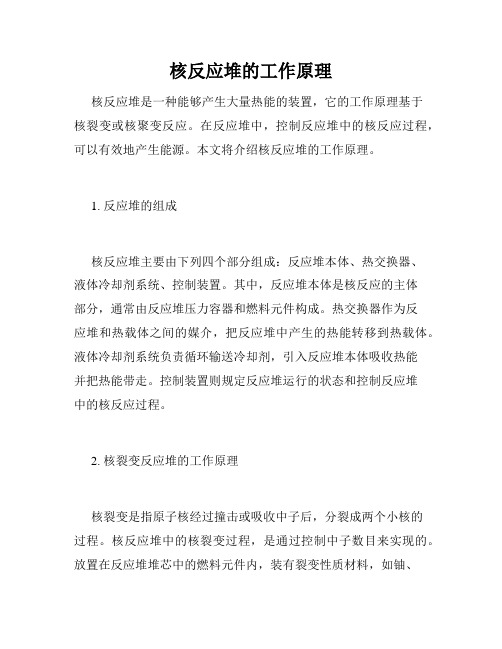
核反应堆的工作原理核反应堆是一种能够产生大量热能的装置,它的工作原理基于核裂变或核聚变反应。
在反应堆中,控制反应堆中的核反应过程,可以有效地产生能源。
本文将介绍核反应堆的工作原理。
1. 反应堆的组成核反应堆主要由下列四个部分组成:反应堆本体、热交换器、液体冷却剂系统、控制装置。
其中,反应堆本体是核反应的主体部分,通常由反应堆压力容器和燃料元件构成。
热交换器作为反应堆和热载体之间的媒介,把反应堆中产生的热能转移到热载体。
液体冷却剂系统负责循环输送冷却剂,引入反应堆本体吸收热能并把热能带走。
控制装置则规定反应堆运行的状态和控制反应堆中的核反应过程。
2. 核裂变反应堆的工作原理核裂变是指原子核经过撞击或吸收中子后,分裂成两个小核的过程。
核反应堆中的核裂变过程,是通过控制中子数目来实现的。
放置在反应堆堆芯中的燃料元件内,装有裂变性质材料,如铀、钚。
燃料元件中的中子和核反应发生接触,这将引起能量的释放,同时释放的中子也将其传递给燃料元件周围的其他裂变性质材料,从而维持产生反应的连锁反应。
核反应堆内的燃料元件一般被设计为长而细的柱状结构。
这种燃料元件又被称为燃料棒,它由轻水产生恒温的管道包裹封装而成。
燃料棒被设计为充满这种裂变材料,通常是铀235或钚239。
这些材料的裂变会释放出大量的中子和热能,从而使周围的裂变性质材料开始分裂。
这创建了一个新的问题,也就是控制连锁反应,确保核反应堆的稳定,同时产生大量的热能。
3. 冷却系统的作用核反应堆产生的大量热能需要被持续地带走,以确保核反应堆内部各部件不过热而损坏。
为此,设计者开发了各种不同类型的冷却系统,其中以液态氢氦(LHe)和液态金属最为常见。
液体冷却系统的工作原理是,将液体冷却剂引入反应堆本体,吸收产生的热能并把其带走。
随后,冷却剂通过热交换器,将其余的载热量转移给工作介质,从而产生出用于驱动发电机或提供热能的大量热能。
4. 避免事故的措施核能源是很危险的,核反应堆事故有可能导致严重的放射性污染。
核反应堆的设计与控制棒原理

核反应堆的设计与控制棒原理核反应堆是一种利用核裂变或核聚变反应产生能量的装置。
它由多个关键组件组成,其中控制棒是核反应堆中至关重要的部分。
本文将介绍核反应堆的设计原理以及控制棒的工作原理。
一、核反应堆的设计原理核反应堆的设计原理是基于核裂变或核聚变反应的原理。
核裂变是指重核(如铀、钚等)被中子轰击后分裂成两个或多个轻核的过程,同时释放出大量的能量和中子。
核聚变是指轻核(如氘、氚等)在高温和高压条件下融合成重核的过程,同样释放出大量的能量。
核反应堆的设计目的是实现可控的核反应过程,以产生持续的能量输出。
为了实现这一目标,核反应堆需要满足以下几个关键要求:1. 反应堆热工学平衡:核反应堆需要保持稳定的温度和压力,以确保反应过程的可控性和安全性。
2. 中子平衡:核反应堆需要保持中子的数量和能量在合适的范围内,以维持核反应的持续进行。
3. 安全性设计:核反应堆需要具备一系列安全措施,以应对可能的事故和故障情况,保障人员和环境的安全。
4. 燃料循环:核反应堆需要设计燃料循环系统,以实现燃料的补充和废物的处理,确保核反应的可持续性。
二、控制棒的工作原理控制棒是核反应堆中用于调节核反应速率的关键部件。
它通常由吸中子材料(如硼、银等)制成,具有吸收中子的能力。
控制棒的工作原理如下:1. 调节核反应速率:控制棒的插入和抽出可以调节核反应堆中的中子流量。
当控制棒完全插入时,它会吸收大量中子,减少中子的数量,从而降低核反应速率。
相反,当控制棒完全抽出时,它不会吸收中子,中子的数量增加,核反应速率增加。
2. 紧急停堆:在核反应堆发生事故或故障时,控制棒可以被紧急插入到反应堆中,以迅速降低核反应速率,避免进一步的事故发生。
3. 温度补偿:控制棒通常具有温度补偿功能,即随着反应堆温度的升高,控制棒的吸收能力会减弱,从而保持核反应的稳定性。
控制棒的设计和布置是核反应堆设计中的重要考虑因素。
合理的控制棒设计可以确保核反应堆的稳定性和安全性。
核反应堆的工作原理和构造
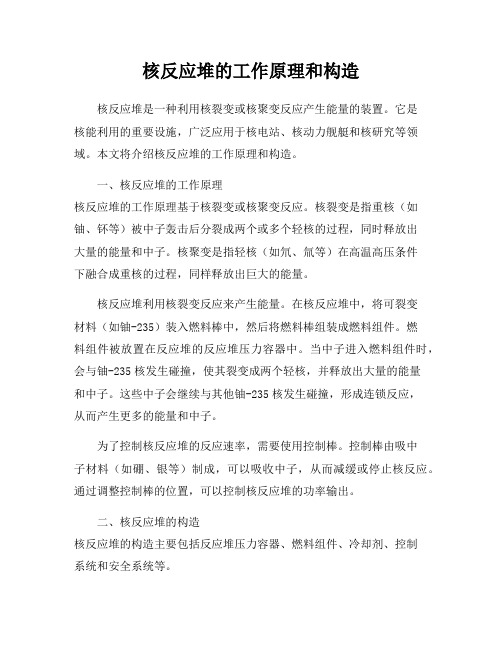
核反应堆的工作原理和构造核反应堆是一种利用核裂变或核聚变反应产生能量的装置。
它是核能利用的重要设施,广泛应用于核电站、核动力舰艇和核研究等领域。
本文将介绍核反应堆的工作原理和构造。
一、核反应堆的工作原理核反应堆的工作原理基于核裂变或核聚变反应。
核裂变是指重核(如铀、钚等)被中子轰击后分裂成两个或多个轻核的过程,同时释放出大量的能量和中子。
核聚变是指轻核(如氘、氚等)在高温高压条件下融合成重核的过程,同样释放出巨大的能量。
核反应堆利用核裂变反应来产生能量。
在核反应堆中,将可裂变材料(如铀-235)装入燃料棒中,然后将燃料棒组装成燃料组件。
燃料组件被放置在反应堆的反应堆压力容器中。
当中子进入燃料组件时,会与铀-235核发生碰撞,使其裂变成两个轻核,并释放出大量的能量和中子。
这些中子会继续与其他铀-235核发生碰撞,形成连锁反应,从而产生更多的能量和中子。
为了控制核反应堆的反应速率,需要使用控制棒。
控制棒由吸中子材料(如硼、银等)制成,可以吸收中子,从而减缓或停止核反应。
通过调整控制棒的位置,可以控制核反应堆的功率输出。
二、核反应堆的构造核反应堆的构造主要包括反应堆压力容器、燃料组件、冷却剂、控制系统和安全系统等。
1. 反应堆压力容器:反应堆压力容器是核反应堆的主要组成部分,用于容纳燃料组件和冷却剂,并承受核反应过程中产生的高温高压。
反应堆压力容器通常由厚重的钢材制成,具有良好的密封性和强度。
2. 燃料组件:燃料组件是核反应堆中的核燃料载体,通常由燃料棒和燃料包壳组成。
燃料棒内装有可裂变材料,如铀-235,燃料包壳则起到保护燃料棒和防止核燃料泄漏的作用。
3. 冷却剂:冷却剂在核反应堆中起到冷却燃料和控制反应速率的作用。
常用的冷却剂包括水、重水、氦气等。
冷却剂通过循环流动,带走燃料棒中产生的热量,并将其转移到蒸汽发生器中,进而产生蒸汽驱动涡轮发电机组发电。
4. 控制系统:核反应堆的控制系统用于控制核反应的速率和功率输出。
核反应堆的工作原理和安全性
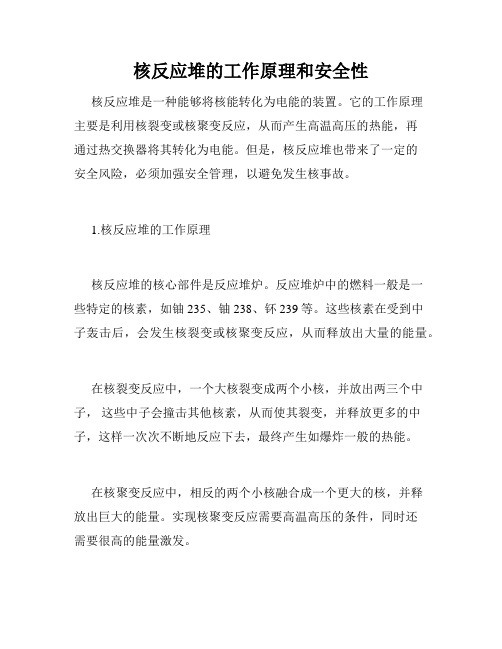
核反应堆的工作原理和安全性核反应堆是一种能够将核能转化为电能的装置。
它的工作原理主要是利用核裂变或核聚变反应,从而产生高温高压的热能,再通过热交换器将其转化为电能。
但是,核反应堆也带来了一定的安全风险,必须加强安全管理,以避免发生核事故。
1.核反应堆的工作原理核反应堆的核心部件是反应堆炉。
反应堆炉中的燃料一般是一些特定的核素,如铀235、铀238、钚239等。
这些核素在受到中子轰击后,会发生核裂变或核聚变反应,从而释放出大量的能量。
在核裂变反应中,一个大核裂变成两个小核,并放出两三个中子,这些中子会撞击其他核素,从而使其裂变,并释放更多的中子,这样一次次不断地反应下去,最终产生如爆炸一般的热能。
在核聚变反应中,相反的两个小核融合成一个更大的核,并释放出巨大的能量。
实现核聚变反应需要高温高压的条件,同时还需要很高的能量激发。
不同类型的核反应堆需要不同的燃料和反应方式。
例如,目前最常见的核反应堆是基于铀235燃料的热中子反应堆,而核聚变反应堆还处于试验阶段。
2.核反应堆的安全性核反应堆的安全性主要包括设计安全、运行安全、辐射安全等方面。
其中,设计安全是保证核反应堆长期稳定运行的基础,而运行安全则是保证核反应堆在正常运行过程中不发生事故。
在设计方面,核反应堆的结构和材料必须能够承受高温高压的条件,同时还需要考虑到燃料的选择和后处理等因素。
此外,核反应堆的物理参数和控制系统也必须与其预期功率匹配,以确保其长期稳定运行。
在运行方面,核反应堆必须严格遵守操作规程,保证燃料的正确投入和正常运行。
核反应堆还需要安装辐射监测设备,对潜在的辐射泄漏进行监测和报警处理。
除了设计安全和运行安全,核反应堆的辐射安全也是保障人员和环境安全的重要方面。
对于核反应堆工作人员,必须严格遵守辐射防护措施,如低剂量长时间暴露、使用防护服、建立辐射监测体系等。
对于周围环境,核反应堆必须加强环境监测和安全管理,确保核反应堆不会对周围环境造成污染和影响。
核电站的核反应堆是如何运行的

核电站的核反应堆是如何运行的核电站的核反应堆是通过利用核裂变反应来产生能量的一种设备。
核裂变反应是指将重原子核分裂成两个或更多的碎片,同时释放出大量能量的过程。
下面将详细介绍核电站的核反应堆是如何运行的。
一、核电站的基本构成核电站一般由核反应堆、冷却系统、控制系统、辐射屏蔽和发电机组成。
核反应堆是核电站的核心部件,主要用于产生热能。
冷却系统负责将核反应堆中产生的热能带走,并将其转化为蒸汽。
控制系统用于控制核反应堆的运行状态。
辐射屏蔽用于防止辐射泄露。
发电机则通过蒸汽驱动发电。
二、核反应堆的工作原理核反应堆的工作原理基于核裂变反应。
核裂变反应是通过轰击一定速度与精确能量的中子来撞击核燃料,使得核燃料发生裂变反应,从而产生大量的热能。
核反应堆中的核燃料通常采用铀或钚等放射性元素。
核反应堆中的燃料棒是核反应的关键部件。
燃料棒是由包裹着放射性燃料的金属或陶瓷制成的柱状物体。
在核反应堆中,多个燃料棒被排列在一起形成燃料组件。
燃料组件中的燃料棒在裂变反应中会产生大量的热能和中子。
为了控制核反应堆的反应过程,需要使用控制棒。
控制棒由吸中子材料制成,其主要作用是吸收中子,减缓核反应堆中的裂变反应速度。
通过调整控制棒的深入程度,可以控制反应堆的输出功率和稳定工作状态。
核反应堆的核裂变反应产生的热能会通过冷却剂带走。
冷却剂一般是水或重水,它与燃料棒之间通过热交换的方式实现热能传递。
冷却剂在核反应堆中发生沸腾,产生的蒸汽经过再热和高压后进入蒸汽涡轮发电机组,最终产生电能。
三、核反应堆的安全措施核反应堆的运行需要严格的安全措施。
主要包括以下几个方面:1. 核反应堆的设计:核反应堆的设计需要充分考虑安全性,并采取措施确保核反应堆的稳定性及避免事故发生。
2. 辐射屏蔽:核反应堆周围会设置辐射屏蔽,以防止辐射泄露,保护工作人员和环境的安全。
3. 控制棒:控制棒的调控非常重要,它可以调整核反应堆的输出功率和稳定性,及时响应异常情况。
核反应堆技术简介

核反应堆技术简介核反应堆技术是一种利用核裂变或核聚变反应产生能量的技术。
核反应堆是核能发电的核心设备,它能够将核能转化为热能,再通过热能转换为电能。
本文将对核反应堆技术进行简要介绍。
一、核反应堆的基本原理核反应堆利用核裂变或核聚变反应释放出的能量来产生热能,进而驱动发电机发电。
核裂变是指重核(如铀、钚等)被中子轰击后分裂成两个或多个轻核的过程,同时释放出大量的能量和中子。
核聚变是指轻核(如氢、氦等)在高温和高压条件下融合成重核的过程,同样也会释放出巨大的能量。
核反应堆中的燃料一般采用铀、钚等重核,通过控制中子的速度和密度,使其与燃料发生核裂变反应。
核裂变反应产生的中子会继续与其他燃料发生反应,形成连锁反应。
为了控制连锁反应的速度,核反应堆中通常会加入一种称为“控制棒”的装置,通过调整控制棒的位置来控制中子的密度,从而控制反应的速度。
核反应堆中的燃料棒是核反应堆的核心部件,它是由燃料和包覆材料组成的。
燃料一般采用铀-235或钚-239等可裂变核素,包覆材料则是用来保护燃料,防止辐射泄漏和燃料损耗。
燃料棒的排列形式有很多种,常见的有方形排列和六边形排列。
二、核反应堆的类型核反应堆根据使用的燃料和工作原理的不同,可以分为多种类型。
常见的核反应堆类型包括压水堆(PWR)、沸水堆(BWR)、重水堆(CANDU)、气冷堆(AGR)等。
1. 压水堆(PWR)压水堆是目前最常见的核反应堆类型,它使用普通水作为冷却剂和减速剂。
核反应堆中的燃料棒被放置在压力容器中,水通过燃料棒周围的管道,吸收燃料产生的热量,然后通过蒸汽发生器转化为蒸汽,驱动涡轮发电机组发电。
2. 沸水堆(BWR)沸水堆也使用普通水作为冷却剂和减速剂,但与压水堆不同的是,沸水堆中的水直接与燃料棒接触,燃料产生的热量直接将水加热为蒸汽,然后通过蒸汽发生器转化为蒸汽,驱动涡轮发电机组发电。
3. 重水堆(CANDU)重水堆使用重水(氘氧化物)作为冷却剂和减速剂。
核反应堆的运行原理

核反应堆的运行原理核反应堆是一种利用核裂变或核聚变反应产生能量的装置。
它是核能利用的重要设施,广泛应用于核电站、核动力舰艇等领域。
核反应堆的运行原理涉及到核裂变链式反应、热量传递和控制系统等多个方面。
一、核裂变链式反应核反应堆的运行原理基于核裂变链式反应。
核裂变是指重核(如铀、钚等)被中子轰击后分裂成两个或多个轻核的过程。
在核反应堆中,中子被引入裂变材料中,使其发生裂变反应。
裂变反应产生的中子又会引发更多的裂变反应,形成一个连锁反应的过程,释放出大量的能量。
二、热量传递核反应堆中的核裂变反应会释放出大量的热能。
为了有效利用这些热能,核反应堆内部设置了热交换系统。
燃料元件中的热能通过导热传递到冷却剂(如水、氦气等)中,使其升温并转化为蒸汽。
蒸汽经过高压管道输送到汽轮机中,驱动汽轮机旋转,产生机械能。
机械能再通过发电机转化为电能,供应给电网或其他设备使用。
三、控制系统核反应堆的运行需要保持裂变反应处于可控状态,以防止核链式反应失控。
为此,核反应堆配备了控制系统。
控制系统主要包括控制棒和冷却剂循环系统。
控制棒是由吸中子材料制成的,可以插入或抽出核反应堆的燃料元件中,用于调节中子的数量和速度,从而控制裂变反应的强度。
冷却剂循环系统则负责调节核反应堆内部的温度和压力,保持反应堆的稳定运行。
四、安全措施核反应堆的运行需要严格的安全措施。
核反应堆中的燃料元件需要进行严格的设计和制造,以确保其在高温、高压和辐射环境下的稳定性和安全性。
此外,核反应堆还需要配备安全系统,如紧急停堆装置、冷却剂泄漏探测器等,以应对可能发生的事故和故障,保障人员和环境的安全。
总结起来,核反应堆的运行原理主要包括核裂变链式反应、热量传递和控制系统。
核裂变链式反应产生的热能通过热交换系统转化为机械能和电能。
控制系统和安全措施保证核反应堆的稳定运行和安全性。
核反应堆的运行原理是核能利用的基础,对于推动核能技术的发展和应用具有重要意义。
核反应堆知识点

核反应堆知识点核反应堆是用来产生核能的设备,它通过核裂变或核聚变反应释放大量能量。
核反应堆广泛应用于能源生产、医疗、工业和科研等领域。
本文将介绍核反应堆的基本原理、构造、种类以及其在不同领域的应用。
一、核反应堆的基本原理核反应堆利用核裂变或核聚变反应过程中释放的能量来产生热能或电能。
核裂变是指重核(如铀、钚等)在吸收中子后分裂成两个或更多的轻核的过程,这种过程会释放大量的能量。
而核聚变是指轻核(如氢)在高温、高压条件下融合形成较重的核,释放出更大的能量。
核反应堆的基本原理是通过控制中子的释放和吸收来控制核裂变或核聚变过程。
当中子被引入反应堆中,它们会与核燃料发生作用,进而引发核反应。
核反应堆中的反应物质通常是铀或钚等可裂变材料,也可以是氢等可聚变材料。
二、核反应堆的构造核反应堆由反应堆堆芯、冷却剂、控制棒、反应堆容器等部分组成。
1. 反应堆堆芯:反应堆堆芯是核反应堆中最重要的部分,它包含核燃料和中子俘获材料。
核燃料是指发生裂变或聚变反应的物质,通常是铀、钚等放射性物质。
中子俘获材料用于控制中子流,常见的材料包括硼、银等。
2. 冷却剂:冷却剂是用来带走反应堆产生的热能,同时也起到控制温度的作用。
常见的冷却剂包括水、氦气等。
不同类型的反应堆使用不同的冷却剂。
3. 控制棒:控制棒用来控制核反应堆中的中子流量,调节核反应堆的反应速率。
通过插入或抽出控制棒,可以增加或减少中子的释放和吸收。
4. 反应堆容器:反应堆容器是包围核反应堆堆芯的壳体,用来防止辐射泄漏。
反应堆容器通常由厚重的混凝土或钢铁构成,具有很强的防护能力。
三、核反应堆的种类核反应堆按照不同的原理和用途可以分为热中子堆、快中子堆和聚变堆三种主要类型。
1. 热中子堆:热中子堆以热中子作为反应物质,主要用于能源生产。
其反应过程通过控制中子的发射和吸收来调节反应堆的能量输出。
2. 快中子堆:快中子堆以快中子作为反应物质,主要用于产生放射性同位素、进行核辐射疗法和研究物质结构等。
核反应堆工作原理

不同类型的核反应堆 具有不同的优点和缺 点,适用于不同的应
用场景
例如,轻水堆是商业 上最常用的核反应堆 类型之一,具有运行 稳定、维护简单、燃 料成本低等优点,但 也有较低的能量密度 和需要大量冷却水等
缺点
重水堆则使用重水作 为冷却剂和慢化剂, 具有较高的能量密度 和较低的放射性水平, 但燃料成本较高且需 要特殊的重水处理设
有重要的作用
2
随着科技的不断进步和技 术创新,核反应堆的技术 和应用也在不断发展和完
善
3
未来,随着能源需求的增 加和环保要求的提高,核 反应堆将在能源领域发挥
更加重要的作用
-
谢
谢
核反应堆的基本结构和工作原理
基本结构
核反应堆主要由以下几个部分组成
核燃料:这是核反应发 生的物质,通常是铀或 钚
冷却剂:用于将反应堆中 的热量传递出去,通常使 用轻水、重水或氦气
慢化剂:用于减缓核反 应的速率,通常使用石 墨或重水
控制棒:用于控制核反 应的速率,通过吸收中 子来减缓反应
保护壳:用于保护核反应 堆免受外部环境和地震的 影响,通常由厚实的钢壳 和混凝土组成
核反应堆工作原理
2020-xx-xx
-
1
引言
2 核反应堆的基本结构和工作原理
3
核反应堆的类型和特点
4
结论
1
引言
引言
核反应堆是一种利用核能产生能量的装置,它 利用了核反应的能量来产生高温高压的水蒸气,
从而推动蒸汽轮机发电
核反应堆具有高效、安全、清洁的优点,是现 代能源工业的重要组成部分
2
核反应堆的基本结构和工作原 理
安全壳:用于保护公众免 受放射性物质的影响,通 常由厚实的混凝土和钢壳 组成
核反应堆的工作原理分析
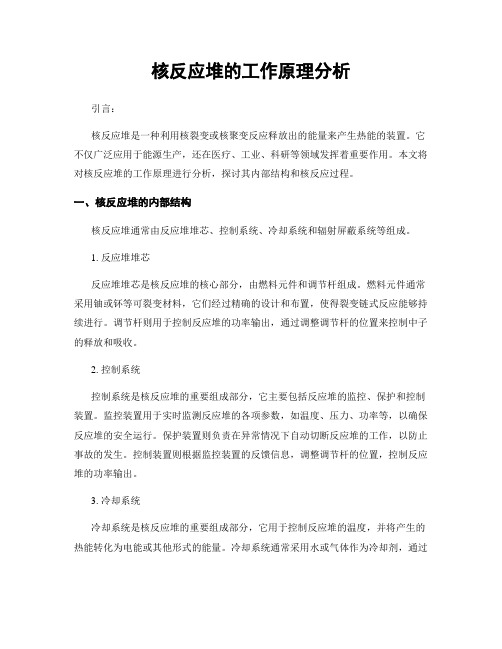
核反应堆的工作原理分析引言:核反应堆是一种利用核裂变或核聚变反应释放出的能量来产生热能的装置。
它不仅广泛应用于能源生产,还在医疗、工业、科研等领域发挥着重要作用。
本文将对核反应堆的工作原理进行分析,探讨其内部结构和核反应过程。
一、核反应堆的内部结构核反应堆通常由反应堆堆芯、控制系统、冷却系统和辐射屏蔽系统等组成。
1. 反应堆堆芯反应堆堆芯是核反应堆的核心部分,由燃料元件和调节杆组成。
燃料元件通常采用铀或钚等可裂变材料,它们经过精确的设计和布置,使得裂变链式反应能够持续进行。
调节杆则用于控制反应堆的功率输出,通过调整调节杆的位置来控制中子的释放和吸收。
2. 控制系统控制系统是核反应堆的重要组成部分,它主要包括反应堆的监控、保护和控制装置。
监控装置用于实时监测反应堆的各项参数,如温度、压力、功率等,以确保反应堆的安全运行。
保护装置则负责在异常情况下自动切断反应堆的工作,以防止事故的发生。
控制装置则根据监控装置的反馈信息,调整调节杆的位置,控制反应堆的功率输出。
3. 冷却系统冷却系统是核反应堆的重要组成部分,它用于控制反应堆的温度,并将产生的热能转化为电能或其他形式的能量。
冷却系统通常采用水或气体作为冷却剂,通过循环流动来带走反应堆中产生的热能。
在冷却过程中,冷却剂与燃料元件之间进行热交换,将燃料元件中的热能传递给冷却剂。
4. 辐射屏蔽系统辐射屏蔽系统用于保护人员和环境免受核辐射的影响。
它通常由厚重的混凝土或铅等材料构成,能够有效吸收和阻挡核辐射。
辐射屏蔽系统的设计和布置需要考虑到核反应堆的辐射特性和周围环境的安全性。
二、核反应堆的核反应过程核反应堆的核反应过程主要包括裂变链式反应和中子的释放与吸收。
1. 裂变链式反应裂变链式反应是核反应堆能量产生的基础。
当中子与可裂变材料(如铀-235)相互作用时,可裂变材料会发生裂变,同时释放出更多的中子。
这些自由中子会继续与其他可裂变材料相互作用,引发更多的裂变反应,形成一个连锁反应的过程。
反应堆工作原理

反应堆工作原理反应堆是一种核能发电装置,其工作原理基于核反应的控制和利用。
通过精确控制核反应堆中的核反应过程,可产生大量的热能,进而驱动发电机组发电。
本文将介绍反应堆的基本工作原理。
一、核反应堆的基本构造核反应堆通常由以下几个主要部分构成:燃料元件、冷却剂、反应堆容器和控制装置。
1. 燃料元件:燃料元件是核反应堆中产生核反应的主要部分。
燃料元件通常由铀、钚等可裂变核燃料构成,并通过精确的设计和布置实现核链式反应。
2. 冷却剂:冷却剂用于吸收核反应中释放出的热能,并将其转移到发电系统中产生蒸汽以驱动涡轮发电机。
冷却剂通常使用水、氦气等。
3. 反应堆容器:反应堆容器是核反应堆的外壳,用于保护核反应堆中的燃料元件,防止辐射泄漏。
4. 控制装置:控制装置用于调整和控制反应堆中的核反应过程。
通过控制装置,可以灵活地调节反应堆中的核反应强度,以满足发电需求。
二、核反应堆的工作原理核反应堆的工作原理基于核分裂和核聚变两种核反应方式。
1. 核分裂反应:核分裂反应是核反应中最常见的一种方式。
通过控制装置,控制反应堆中的中子数目,使其达到裂变反应所需的临界条件。
在核分裂过程中,一个重核裂变成多个轻核并释放出大量的热能。
2. 核聚变反应:核聚变反应是另一种核反应方式。
在核聚变反应中,轻核通过高温和高压的条件下相互融合形成更重的核,同时释放出巨大的能量。
然而,核聚变技术在目前仍处于研究和实验阶段,并未广泛应用于商业核反应堆中。
通过控制和调节核分裂反应的强度,核反应堆可以产生足够的热能以满足发电需求。
核裂变反应释放的热能被吸收并转移到冷却剂中,然后通过传热方式将热能转化为蒸汽驱动发电机运转。
三、核反应堆的安全措施核反应堆是一项高度复杂、高风险的技术,需要严格的安全措施来确保其可靠运行。
1. 辐射防护:核反应堆的设计必须考虑到辐射防护,以确保工作人员和环境的安全。
采用厚重的防护层和高效的辐射防护设备,可以有效降低辐射泄漏的风险。
核电站的核反应堆运作原理

核电站的核反应堆运作原理核电站是通过核反应堆来产生能量的设施,其核心是核反应堆。
核反应堆的运作原理是利用核裂变或核聚变产生的核能,将其转化为热能,再经过热交换转换为电能。
下面将详细介绍核反应堆运作的原理。
一、核裂变反应堆的运作原理核裂变反应堆是目前主要使用的核反应堆类型之一。
其运作原理如下:1. 燃料元素:核裂变反应堆使用的燃料元素通常是铀-235或钚-239等可裂变核素。
这些燃料元素经过特殊处理形成燃料棒,并集中堆放在反应堆中。
2. 中子产生:为了使裂变链式反应能够持续进行,需要引入中子。
反应堆中通常会引入减速剂,如重水或石墨,来减慢高速中子的速度,增加其与燃料之间的相互作用。
3. 裂变反应:当中子速度减慢后,它们会与燃料元素中的可裂变核素碰撞。
当中子能量适当时,就会导致裂变反应发生,释放出大量的能量,并产生新的中子。
这些新产生的中子会继续与周围的可裂变核素发生碰撞,形成裂变链式反应。
4. 调控系统:为了控制裂变反应的速度,反应堆中配备了调控系统。
其主要包括控制棒和反应度调节器。
控制棒通常由吸中子材料制成,可以插入或移出燃料堆,以控制中子的释放和产生速率。
反应度调节器可以调节中子的流动速率,从而控制能量输出。
5. 热交换:核裂变反应产生的能量主要以热能的形式存在。
这些热能通过热交换器传递给工质,如水或氦气,使其变成高温高压的蒸汽。
蒸汽再驱动涡轮发电机组产生电能。
二、核聚变反应堆的运作原理核聚变反应堆是实现太阳核聚变能源的目标之一。
其运作原理如下:1. 燃料元素:核聚变反应堆通常使用氘和氚等轻稳定核素作为燃料。
这些燃料在高温高压环境下形成等离子体状态。
2. 束缚与加热:为了维持等离子体的高温状态,核聚变反应堆需要利用束缚和加热系统。
束缚系统包括磁场或惯性约束,以防止等离子体散开或与反应堆壁碰撞。
加热系统则通过激光、粒子束或其他加热手段将等离子体加热到足够高的温度。
3. 核聚变反应:在高温高压的环境下,氘和氚核会发生聚变反应,生成氦核和释放出大量的能量。
核反应堆工作原理
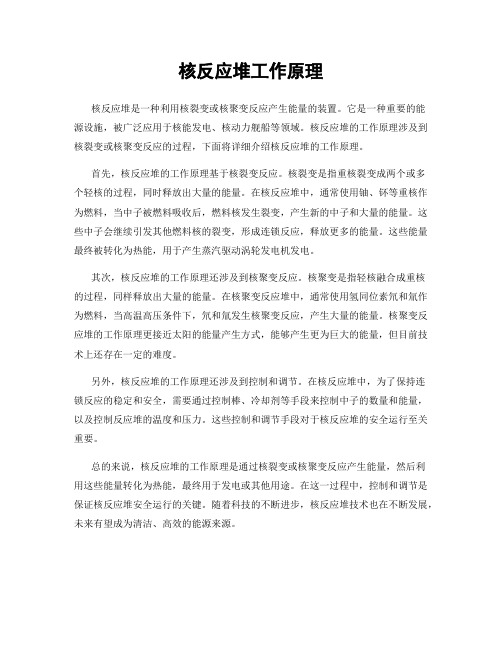
核反应堆工作原理核反应堆是一种利用核裂变或核聚变反应产生能量的装置。
它是一种重要的能源设施,被广泛应用于核能发电、核动力舰船等领域。
核反应堆的工作原理涉及到核裂变或核聚变反应的过程,下面将详细介绍核反应堆的工作原理。
首先,核反应堆的工作原理基于核裂变反应。
核裂变是指重核裂变成两个或多个轻核的过程,同时释放出大量的能量。
在核反应堆中,通常使用铀、钚等重核作为燃料,当中子被燃料吸收后,燃料核发生裂变,产生新的中子和大量的能量。
这些中子会继续引发其他燃料核的裂变,形成连锁反应,释放更多的能量。
这些能量最终被转化为热能,用于产生蒸汽驱动涡轮发电机发电。
其次,核反应堆的工作原理还涉及到核聚变反应。
核聚变是指轻核融合成重核的过程,同样释放出大量的能量。
在核聚变反应堆中,通常使用氢同位素氘和氚作为燃料,当高温高压条件下,氘和氚发生核聚变反应,产生大量的能量。
核聚变反应堆的工作原理更接近太阳的能量产生方式,能够产生更为巨大的能量,但目前技术上还存在一定的难度。
另外,核反应堆的工作原理还涉及到控制和调节。
在核反应堆中,为了保持连锁反应的稳定和安全,需要通过控制棒、冷却剂等手段来控制中子的数量和能量,以及控制反应堆的温度和压力。
这些控制和调节手段对于核反应堆的安全运行至关重要。
总的来说,核反应堆的工作原理是通过核裂变或核聚变反应产生能量,然后利用这些能量转化为热能,最终用于发电或其他用途。
在这一过程中,控制和调节是保证核反应堆安全运行的关键。
随着科技的不断进步,核反应堆技术也在不断发展,未来有望成为清洁、高效的能源来源。
什么是反应堆

什么是反应堆反应堆是一种用于进行核反应的设备,它是核能利用的重要组成部分。
本文将介绍反应堆的基本概念、工作原理、种类以及应用领域。
一、基本概念反应堆是指能维持和控制核反应的结构,通过核裂变或核聚变产生大量能量。
它通常由燃料、冷却剂、冷却剂循环系统、控制系统、反应堆压力容器、屏蔽材料等组成。
二、工作原理反应堆中的核反应是通过控制核裂变链式反应来实现的。
核燃料经过裂变释放出的中子引发新的裂变反应,形成链式反应。
同时,通过控制系统调整反应速率,维持核链式反应处于稳定状态。
三、种类1. 根据燃料类型:(1)热中子反应堆:使用热中子来维持链式反应,主要燃料为铀-235或钚-239等。
(2)快中子反应堆:使用快中子来维持链式反应,主要燃料为钚-239或铀-233等。
2. 根据冷却剂类型:(1)水冷反应堆:使用水作为冷却剂,主要有压水堆和沸水堆等类型。
(2)气冷反应堆:使用氦气或二氧化碳作为冷却剂,可以提高燃料利用率。
(3)液态金属冷却反应堆:使用钠或铅等液态金属作为冷却剂,具有良好的传热性能和安全性。
3. 根据反应堆用途:(1)核电站反应堆:用于发电,主要以压水堆和沸水堆为主。
(2)核动力反应堆:用于舰船、潜艇等核动力设备,主要以压水堆为主。
(3)核研究反应堆:用于核科学研究和同位素生产等,种类多样化。
四、应用领域反应堆在能源、医学、环境保护等领域具有广泛应用:1. 能源领域:核电站利用反应堆产生电能,是清洁能源的重要组成部分。
2. 医学领域:核反应堆可以用于医学同位素生产,用于放射治疗、医学影像等。
3. 环境保护领域:核技术可以用于处理放射性废物、监测环境污染等。
总结:反应堆是核能利用的基础设施,它能以安全有效的方式利用核能,产生电能、医学同位素等。
不同类型的反应堆在不同的领域有着广泛的应用,为人们的生活和社会发展提供了重要支持。
核电站反应堆工作原理
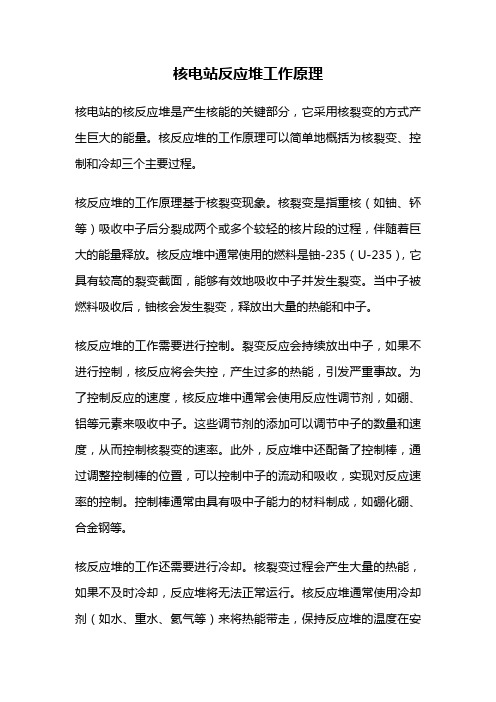
核电站反应堆工作原理核电站的核反应堆是产生核能的关键部分,它采用核裂变的方式产生巨大的能量。
核反应堆的工作原理可以简单地概括为核裂变、控制和冷却三个主要过程。
核反应堆的工作原理基于核裂变现象。
核裂变是指重核(如铀、钚等)吸收中子后分裂成两个或多个较轻的核片段的过程,伴随着巨大的能量释放。
核反应堆中通常使用的燃料是铀-235(U-235),它具有较高的裂变截面,能够有效地吸收中子并发生裂变。
当中子被燃料吸收后,铀核会发生裂变,释放出大量的热能和中子。
核反应堆的工作需要进行控制。
裂变反应会持续放出中子,如果不进行控制,核反应将会失控,产生过多的热能,引发严重事故。
为了控制反应的速度,核反应堆中通常会使用反应性调节剂,如硼、铝等元素来吸收中子。
这些调节剂的添加可以调节中子的数量和速度,从而控制核裂变的速率。
此外,反应堆中还配备了控制棒,通过调整控制棒的位置,可以控制中子的流动和吸收,实现对反应速率的控制。
控制棒通常由具有吸中子能力的材料制成,如硼化硼、合金钢等。
核反应堆的工作还需要进行冷却。
核裂变过程会产生大量的热能,如果不及时冷却,反应堆将无法正常运行。
核反应堆通常使用冷却剂(如水、重水、氦气等)来将热能带走,保持反应堆的温度在安全范围内。
冷却剂通过循环系统流经反应堆,吸收热能后被冷却,然后再次循环流经反应堆,形成一个闭合的循环。
冷却剂的选择和循环方式会根据具体的反应堆类型和设计而有所不同。
总结起来,核电站反应堆的工作原理可简要概括为核裂变、控制和冷却三个过程。
核裂变产生的热能需要通过控制棒和反应性调节剂进行控制,以保持核反应的稳定性和安全性。
同时,冷却剂的循环流动将热能带走,保持反应堆的温度在安全范围内。
这些过程相互配合,使核反应堆能够持续地产生巨大的能量,为人们提供清洁、高效的电力供应。
核反应堆的运行与控制系统

核反应堆的运行与控制系统核反应堆是一种利用核裂变或核聚变反应产生能量的装置,它在能源领域具有重要的地位。
核反应堆的运行与控制系统是确保核反应堆安全稳定运行的关键。
本文将介绍核反应堆的运行原理和控制系统的功能。
一、核反应堆的运行原理核反应堆利用核裂变或核聚变反应释放出的能量来产生热能,进而转化为电能或其他形式的能量。
核裂变反应是指重核(如铀、钚等)被中子轰击后发生裂变,释放出大量的能量和中子。
核聚变反应是指轻核(如氢、氦等)在高温高压条件下发生融合,释放出巨大的能量。
核反应堆的运行过程可以简单概括为以下几个步骤:1. 中子产生:核反应堆中需要有足够的中子来维持反应链式反应。
中子可以通过裂变反应释放出来,也可以通过中子源(如放射性同位素)提供。
2. 中子传输:中子在反应堆中传输,与核燃料发生相互作用。
3. 反应发生:中子与核燃料发生相互作用,引发核裂变或核聚变反应。
4. 能量释放:核裂变或核聚变反应释放出的能量以热能的形式传递给工质(如水、气体等)。
5. 能量转化:热能通过热交换器转化为电能或其他形式的能量。
二、核反应堆的控制系统核反应堆的控制系统是确保核反应堆安全稳定运行的关键。
它主要包括以下几个方面的功能:1. 反应堆功率控制:核反应堆的功率需要在一定范围内进行控制,以满足不同负荷需求。
控制系统通过调整控制棒的位置来控制中子的流动,从而控制反应堆的功率。
2. 温度控制:核反应堆的温度需要在一定范围内进行控制,以确保燃料元件和冷却剂的安全性。
控制系统通过调整冷却剂的流量和温度来控制反应堆的温度。
3. 压力控制:核反应堆的压力需要在一定范围内进行控制,以确保冷却剂的循环和热交换的正常运行。
控制系统通过调整冷却剂的流量和压力来控制反应堆的压力。
4. 中子源控制:核反应堆中的中子源需要进行控制,以确保反应链式反应的持续进行。
控制系统通过调整中子源的位置和强度来控制中子的产生和传输。
5. 安全保护:核反应堆的控制系统还需要具备安全保护功能,以应对突发事件和异常情况。
核反应堆的工作原理

核反应堆的工作原理核反应堆是一种利用核裂变或核聚变反应产生能量的装置。
它是核能利用的重要设备,广泛应用于核电站、核动力舰艇等领域。
核反应堆的工作原理涉及到核裂变或核聚变反应的控制和调节,下面将详细介绍核反应堆的工作原理。
一、核裂变反应堆的工作原理核裂变反应堆是利用重核(如铀、钚等)的裂变反应产生能量的装置。
其工作原理如下:1. 燃料选择:核裂变反应堆的燃料通常选择铀-235或钚-239等可裂变核素。
这些核素在吸收中子后会发生裂变,释放出大量的能量。
2. 中子控制:核裂变反应需要中子的参与。
中子是一种无电荷的粒子,它在核反应堆中起到引发和维持裂变链式反应的作用。
为了控制反应的速率,需要通过控制中子的数量和能量来实现。
3. 反应堆结构:核裂变反应堆通常由燃料元件、冷却剂、反应堆容器和控制系统等组成。
燃料元件中含有可裂变核素,冷却剂用于带走反应堆中产生的热量,反应堆容器用于容纳燃料元件和冷却剂,控制系统用于控制反应的速率。
4. 反应过程:核裂变反应堆中,中子与燃料元件中的可裂变核素发生碰撞,使其发生裂变,释放出大量的能量和中子。
这些中子又会继续引发其他核素的裂变,形成裂变链式反应。
通过控制中子的数量和能量,可以控制反应的速率。
5. 热量利用:核裂变反应堆产生的能量主要以热的形式释放出来。
冷却剂通过与燃料元件接触,带走燃料元件中产生的热量,然后通过热交换器将热能转化为电能或其他形式的能量。
二、核聚变反应堆的工作原理核聚变反应堆是利用轻核(如氘、氚等)的聚变反应产生能量的装置。
其工作原理如下:1. 燃料选择:核聚变反应堆的燃料通常选择氘和氚等轻核。
这些核素在高温和高压条件下会发生聚变反应,释放出大量的能量。
2. 温度和压力控制:核聚变反应需要高温和高压的条件。
通过控制反应堆中的温度和压力,可以实现核聚变反应的进行。
3. 反应堆结构:核聚变反应堆通常由燃料元件、冷却剂、反应堆容器和控制系统等组成。
燃料元件中含有氘和氚等轻核,冷却剂用于维持反应堆中的温度和压力,反应堆容器用于容纳燃料元件和冷却剂,控制系统用于控制反应的速率。
- 1、下载文档前请自行甄别文档内容的完整性,平台不提供额外的编辑、内容补充、找答案等附加服务。
- 2、"仅部分预览"的文档,不可在线预览部分如存在完整性等问题,可反馈申请退款(可完整预览的文档不适用该条件!)。
- 3、如文档侵犯您的权益,请联系客服反馈,我们会尽快为您处理(人工客服工作时间:9:00-18:30)。
核反应堆及其工作原理
日本地震引发的核泄漏危机使得人心惶惶,网上各种瞎扯的消息铺天盖地,与其在假消息中挣扎,倒不如来普及一下科学知识。
核反应堆究竟是什么东西?它的工作原理是怎样的?今天我们就来图解福岛核电站故障。
核反应堆相关词汇表:
core 核心
control rod s 控制棒
reactor vessel反应堆
suppression pool 抑压池
primary containment vessel 第一层安全壳(反应堆外壳)
secondary containment building 第二层安全壳
turbine涡轮
condenser冷凝器
backup steam generator备用蒸汽发电机
Normal operation
正常状态
In operation since the early 1970s, Japan's Fukushima Daiichi nuclear plant uses six boiling water reactors, which rely on uranium nuclear fission to generate heat. Water surrounding the core boils into steam that drives turbines to generate electricity.
The reactor vessel is surrounded by a thick steel-and-concrete primary containment vessel, equipped with a water reservoir designed to suppress overheating of the vessel.
反应堆由一个钢与混凝土构成的厚实外壳(第一层安全壳)保护着,另外还配有一个蓄水库,防止反应堆过热。
The suppression pool is designed to protect the primary vessel if the core gets too hot. Valves release steam into the pool, where it condenses, relieving dangerous pressure.
当核心过热时,抑压池可以起到保护第一层安全壳的作用。
这时阀门会打开,水蒸气就能进入抑压池内冷凝,减缓压力过大造成的危险。
Earthquake damage
地震时
The earthquake initiated a rapid shutdown of the reactors, but the disaster cut power to controls and pumps, and the tsunami disabled backup generators. New diesel generators were delivered after batteries used to control the operation of the reactor were exhausted.
周五的地震切断了各种控制系统和水泵的电力供应,而海啸又使备用发电机组无法工作。
在控制反应堆运作的电池报废后,不得不启用第二套柴油发电机。
Since the quake hit, fuel rods in the cores of reactor 1, 2 and 3 have overheated because of a lack of cooling water.
自地震以来,由于冷却用水的缺少,1、2、3号反应堆核心中的燃料棒一直处于过热状态。
Control rods were inserted into the cores to stop fission, but cores need several days to cool down. 控制棒已经插入,但是核心需要好几天时间来冷却。
Trying to cool the reactors
尝试冷却反应堆
Cores in units 1, 2 and 3 heated up to the extent that the zirconium covering the fuel reacted with steam, releasing hydrogen gas. Hydrogen collected in the secondary containment buildings, where it exploded, blowing the tops off units 1 and 3, and damaging the cooling system of unit 2.
1、2、3号反应堆核心的温度升高到了一定程度,使得覆盖在燃料棒上的锆元素与水蒸气产生了反应,释放出了氢气。
氢气在第二层安全壳内聚集,最终爆炸,将1号和3号的顶盖炸飞,损毁了2号的冷却系统。
Primary containment vessels in units 1 and 3 are reportedly intact, but a structure in unit 2 has cracked, preventing water from fully covering the core.
报道中称1号和3号的反应堆外壳是完好的,但是2号反应堆中的某个构架被炸坏了,致使水无法完全淹没核心。
Attempting to cool the cores, engineers are flooding cores and their containment vessels with seawater and boric acid, which acts to dampen fission reactions.
为了冷却核心,工程师们灌入掺了硼酸的海水,让核心及安全壳浸没在其内,以起到抑制裂变反应的作用。
Two worst-case scenarios
两种最坏的情况
If engineers are unable to cool a damaged fuel core, enriched uranium can melt into a pool of radioactive lava. The meltdown can burn its way out of the containment vessel or send radioactive steam out through cracks in the system.
如果工程师们无法成功冷却受损燃料核心,浓缩铀会像一滩具有放射性的熔岩,烧穿安全壳,或者让具有放射性的水蒸气从系统裂缝流入外界。
Cooling the spent fuel is critical, for if it becomes exposed, a zirconium fire can break out and spew massive amounts of radiation.
冷却用过的核燃料至关重要,因为一旦它暴露在外,就可能引发锆火灾,从而排放出大量放射物质。
According to nuclear analyst Kenneth D. Bergeron, the containment vessels at Daiichi are stronger than Chernobyl but not as robust as Three Mile Island.
据核分析师Kenneth D. Bergeron所言,日本福岛第一核电站的安全壳的结实程度比切尔诺贝利的好,却没三里岛的好。
关于切尔诺贝利、三里岛以及这次福岛的核泄漏事故对比,来引用微博网友“功夫猫”的一句经典总结:
举个例子来说,切尔诺贝利那是坐便器和厕所都炸了,溅人一身;三里岛那个是下水道里面冒个泡,厕所里面一股臭气,但是没跑到厕所外面;福岛这个是厕所里面不断冒泡硫化氢太多炸了,臭气大量外溢,但是屎还没出来。
